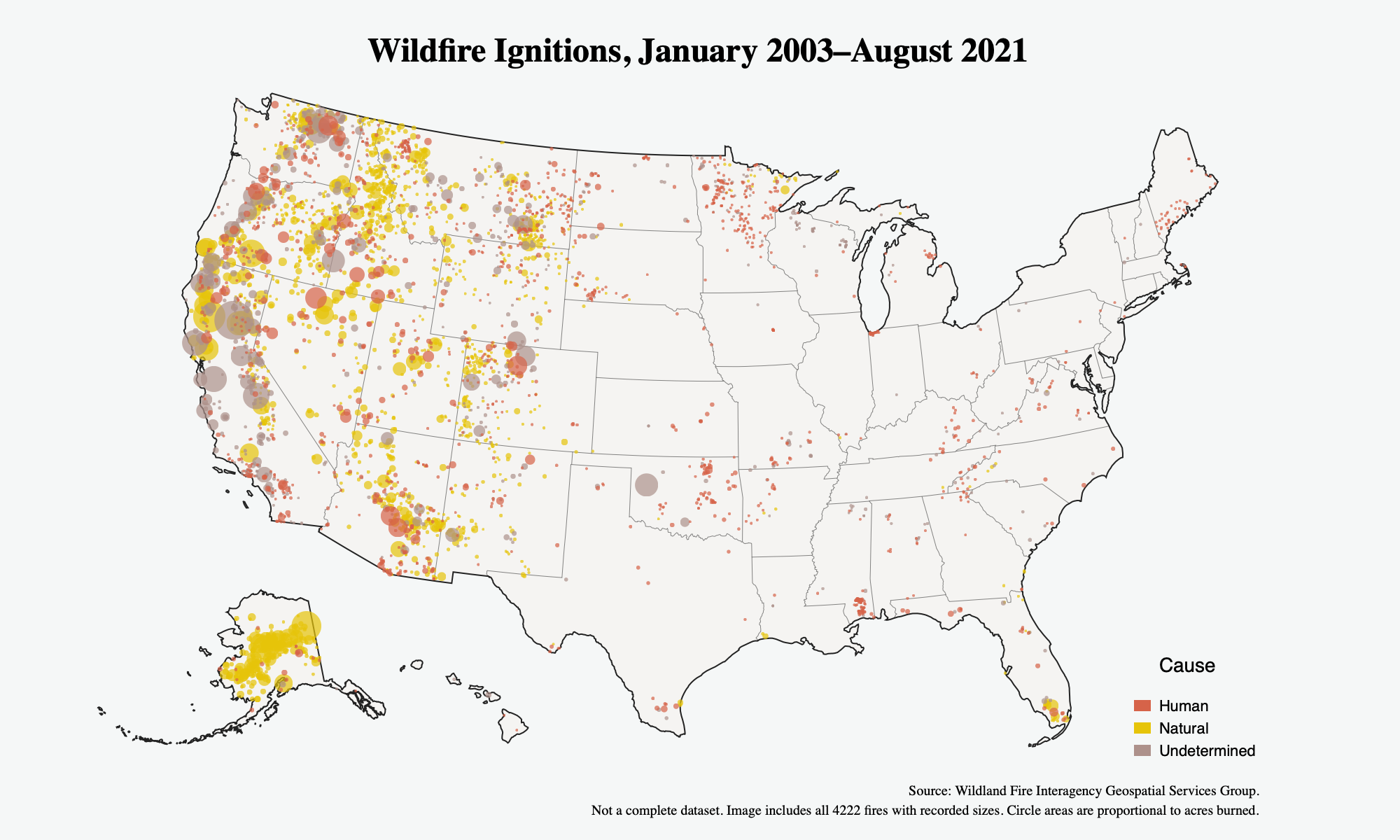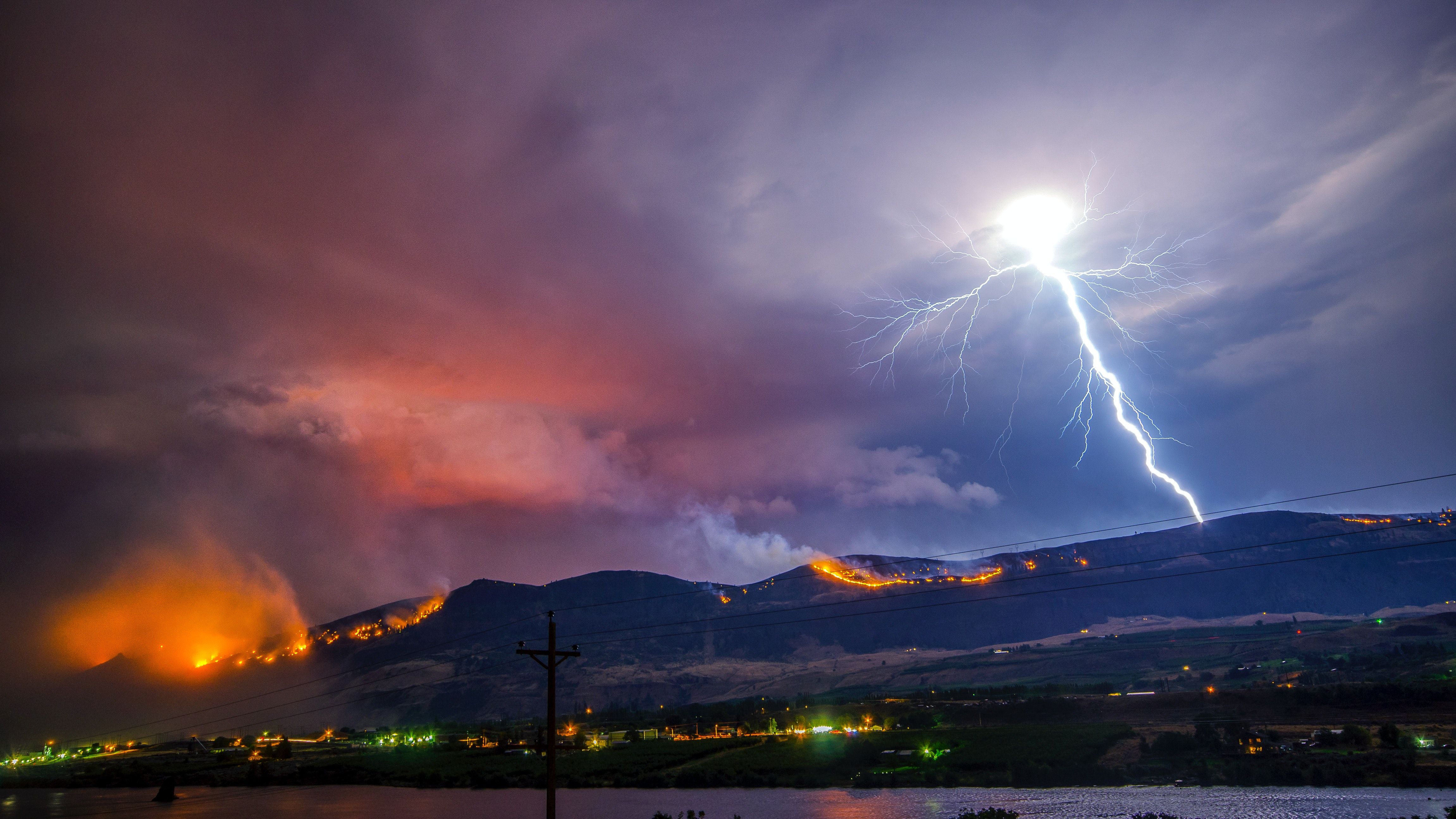How Wildfires Start
Fire needs three things to ignite and sustain itself: heat, fuel, and oxygen. The U.S. fire season lasts from June to September when the weather and vegetation conditions are right to sustain a large blaze. In the last two decades, the fire season has lengthened and fires have had an increasingly destructive impact. Since 2000, an annual average of 70,600 wildfires have burned 7.0 million acres every year, more than double the acreage burned in the 1990s. Much of this increase is due to worsening drought and heat conditions caused by climate change.
Wildfires can be naturally caused or human induced. The overwhelming majority of wildfires, more than 84%, are a result of human activity. Furthermore, human-induced fires are responsible for more than 97% of homes threatened by wildfire. Most human-caused fires are a result of a combination of reckless activities and a lack of fire knowledge and preventative measures. Human-sparked fires tend to be faster and more dangerous than those caused naturally by lighting or storms.

Causes of Wildfires in the U.S.
Debris Burning / Prescribed Fires: 29%
Based on a 2017 study of causes of fire ignition in the U.S., inappropriate burning of yard debris is the number one human-caused source of fire. Prescribed burns are when property owners or government agencies burn yard debris or excess fuels from the forest floor in an attempt to decrease fire threat. It is important to get burn permits for this type of activity.

Regular and carefully controlled burning can help reduce fire risk by eliminating excess flammable debris on the forest floor. Occasionally, a prescribed burn can escape control and become a wildland fire. This is especially common when such burns are attempted by inexperienced individuals or without taking proper precautions.
Arson: 21%
For a wildland fire to be arson, there has to be criminal intent to willfully ignore fire regulations; irresponsible behavior that results in the ignition of a wildland fire does not automatically fall into the category of arson. In the case of reckless behavior, a homeowner still may be responsible for damages.
Equipment Use: 11%
Home and industrial equipment create sparks through improper use which can result in fire. Tractors, lawnmowers, chain saws, welders, weedeaters, and other common equipment are all possible fire hazards. Fire often happens when blades come into contact with rocks hidden within vegetation. Cars can also be responsible for fire if a hot exhaust pipe or muffler comes into contact with dry brush on the side of the road.
Campfires: 5%
Campfires often escape to neighboring areas when they are built or maintained incorrectly. This is most often the result of negligent campers who follow incorrect extinguishing techniques or leave their fire unattended. While campfires are usually allowed without permits, it is important to check daily burning restrictions beforehand and to avoid burning excess debris. Burning in a fire ring with the intent to eliminate debris is not a campfire and does require a burning permit in DNR protection areas.
Firework Use: 5%
Fourth of July is the biggest day of the year for wildfires because of the danger of firework misuse. All fireworks have the potential to cause fire; even sparklers, smoke bombs, and fountains can cause ignition. The safest way to enjoy fireworks is to attend a show planned and executed by professionals.
Smoking: 2%
Careless smoking causes about 2% of all wildfires in the United States. This type of ignition is most common near interstate highways when people throw cigarettes out of moving vehicles. Cigarettes cause far fewer fires than they used to because of a reduction in smoking rates in the United States and self-extinguishing cigarettes.
Lightning / Non-human Causes
Most fires that aren’t human caused are caused by lightning. Other natural causes of fire include lava and coal seam fires. In contrast to human induced fires which are reasonably evenly spread from June to September, 78% of lightning-induced fires have historically happened in the summer (June-August).

How to Protect Your Home and Community from Fire Risk
In most cases, the best way to protect your home from wildfire is to use caution in your own behavior. Careful supervision of any type of fire activity is key to protecting yourself and your family. Use some of these tips to help protect your property and community from fire risk:
Keep Informed
- Frequently check your local risk levels and learn about the specific dangers of each type of wildland fire
- Know the dangers of your location, particularly within the wildland-urban interface (currently 9% of the U.S. but projected to double by 2030 due to homebuilding in or near forested areas).
Yard Maintenance
- Debris: Follow local and state regulations when managing yard debris and consider alternatives to burning. High humidity, low wind, and wet conditions are best. Use barriers and screens when burning debris to help prevent embers from travelling and keep a source of running water nearby.
- Equipment: Use yard management equipment such as weeders and lawnmowers carefully, avoid moving dry vegetation, or in full heat / high winds conditions if you are in a wildlife-urban interface area.
- Yard Management: Trim and/or remove dead trees, especially if they are near structures. Tall trees may attract lightning strikes, and dead trees are great wildfire fuel. You may want to contact an arborist for advice if significant numbers of your trees are dying due to pest or fungus infestation.
- Structure Management: Keep your roof and gutters clear, move flammable materials away from the exterior of your home, and use your landscaping to create fuel breaks.
Recreational Fire Use and Smoking
- Campfires: Maintain proper campfire etiquette: select an appropriate space, build small fires, keep water nearby, attend to your fire actively, and extinguish properly. If not using an existing fire ring, make sure to dig away any organic material under the fire area and replace with mineral soil to prevent underground burns.
- Cooking: Cook with a propane grill or practice proper fire monitoring and extinguishing practices for campfires or charcoal grills, especially drowning or burying your coals.
- Fireworks: Monitor firework use closely and keep lit fireworks away from flammable materials. Or, use lasers, a light show, glowsticks, or bubbles for a safe (and eco friendly) firework alternative.
- Smoking: If you smoke outside, construct a smoking area with non-flammable materials such as concrete. Use an ashtray designed for outdoor use that won’t tip over in high winds. If possible, design a windbreak too.
Conclusion
Using caution when conducting activities likely to cause fire is an important part of reducing fire damage in the United States. However, the recent increase in fire damage has been connected to climate change, not increased levels of human recklessness. Due to increases in heat, drought, and fuel buildup, the same actions that could have caused a small burn in previous years are now creating dangerous infernos. Adaptations to reduce damage from wildfires and knowing the risks of a location before you purchase are therefore increasingly important tools to protect your home.